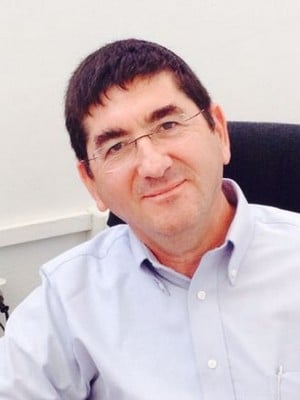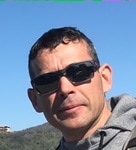Engineering Conference Webinar Photonics
Held on Sunday-Monday, July 5-6, 2020
Playlist
webinar recordings
Sunday, July 5, 2020
16:00-17:00 Optical super-resolved microscopy, Prof Steve Lipson
18:30-19:30 Advanced Laser Welding With Dynamic Beam, DR Eyal Shekel
Monday, July 6, 2020
14:00-15:00 THZ, M. Sc. Enrico Dardanis, Dr. Milan Oeri
16:00-17:00 Photonic Integrated cirquits at Fraunhofer HHI: aplications, opportunities and fabrication, Dr David Felipe Mesquida, Dr Moritz Baier
18:30-19:30 Online optical design, Gil Noy
Sunday, July 5, 2020
16:00-17:00 Optical super-resolved microscopy, Prof Steve Lipson
According to Ernst Abbe’s theory of microscope resolution from 1873, the resolution limit of an image created using incoherent light is λ⁄2″NA” , where the numerical aperture NA is n sinα, n being the refractive index of the medium surrounding the object and α the semi-angle of the imaging lens at its focal point. This leads to a limitation of λ⁄2n for a wide-angle lens. Since Toraldo di Francia’s work in 1952, many efforts have been made to improve on this limit, which culminated in three scientists’ receiving a Nobel Prize in 2014 for techniques using fluorescent labelling. I will discuss the basic physics underlying these techniques and others which have also been developed in the meantime. Today, resolutions more than 50 times better than the Abbe limit have been achieved in the visible spectrum. Super-resolution comes at a price, and the use of information theory allows this to be estimated. I will show that one price is inefficiency in light usage. Another price is a need for pre-knowledge of expected details in the image being investigated, and may include serious limitations of the field of view.
Professor Steve Lipson
Emeritus Professor of Physics at Technion. I received my Ph.D. from the University of Cambridge in England, and have been at Technion since 1966. My work in optics has included super-resolution microscopy, optical investigations of surface roughening in helium crystals at low temperatures, atmospheric transmission of infra-red radiation, adaptive optics for astronomical telescopes and the dynamics of evaporation of thin films. I am a coauthor of the textbook “Optical Physics” (Cambridge University Press, 4th edition 2011) together with my son Ariel Lipson and my late father, Henry Lipson.
18:30-19:30 Advanced Laser Welding With Dynamic Beam, DR Eyal Shekel
In collaboration with the Israeli forum of laser material processing*
Presently a Laser Beam is Dynamic because it is moving from point to point, by mechanical steering a mirror or a mechanical robotic arm. These movements are limited in speed/frequency. Moreover, the energy profile of the beam is fixed throughout the process.
A revolutionary technological improvement developed at CIVAN ADVANCED TECHNOLOGIES, in Jerusalem, allows now to achieve changes of beam energy profile at will, with MHz frequency and at unlimited high power levels.
The beam thus generated can deliver, for example, a highly concentrated oscillating spot associated with pre- or post-heating areas of sizes at will, to optimize the heat input for the specific welding, cutting or heat-treatment application. Unlimited geometrical energy profile shapes can be generated in real time enabling unprecedented processes optimization opportunities.
In Laser Beam Melting 3D printers, the energy distribution of this technology can eliminate the power limitation in present machines of 400-700 W by maintaining concomitantly a large number of melt pools, in similarity to the Electron Beam Melting and also raising the powder bed temperature highly enough to reduce the high stresses developing in this process.
In Butt or Lap Welding the deep melt pool traps gas bubbles because high turbulence in the molten metal. A high frequency oscillation imposed to a high energy spot within the beam reduces the turbulence and the associated porosity. A half-moon energy profile preceding the high energy spot will be beneficial in processing high-heat-conducive metals. A similar heat profile, at the trail side will reduce the cracking of welds of sensitive alloys.
Cutting and drilling will benefit not only from the beam energy profile customization but also from the long focal length possible, because of the high depth of view, keeping the same focus within 4 mm depth.
Surface treatment of materials, such as steel hardening requires a spreading of the energy, regularly done by de-focusing a beam
Dr Eyal Shekel
Dr. Shekel is the founder and CEO of Civan Advanced Technologies Ltd (www.civan.co.il), a Jerusalem based Hi – Tech company in the field of electro optics. Since its establishment in 2008, Civan’s focus has been the development of high power lasers. Civan’s product line includes Single Mode (SM) lasers with Continuous Wave (CW) power ranging from 10 Watt to 10’s of KWatt. The advantages of Civan’s lasers include high reliability, high wall-plug efficiency, energy saving, low cost and low maintenance.
Monday, July 6, 2020
14:00-15:00 THZ, M. Sc. Enrico Dardanis, Dr. Milan Oeri
Terahertz Time-Domain Spectroscopy
The Terahertz (THz) frequency regime, also referred to as the sub-millimeter wave or far-infrared radiation, commonly spans a broad range from 100 to 6000 GHz. Being a blank spot on the available energetic radiation map for many years, newer developments have pushed terahertz to a rapidly emerging technology and to the forefront of innovative, photonic applications in fundamental sciences but also for real-world applications, applied in the spectroscopy or imaging of novel materials and non-destructive investigations.
The THz webinar will provide a fair understanding of the fundamental science of terahertz electrical field generation and detection, with a distinct focus on pulsed, broadband time-domain terahertz spectroscopy (THz-TDS) and imaging. We will review the various technical approaches that enable THz-TDS measurements highlighting their outstanding merits in the vicinity if spectroscopic and imaging solutions but also discuss the pitfalls of terahertz.
Particularly, we draw attention to the cross-disciplinary, multi-purpose use of terahertz TDS providing time-of-flight information on the one hand and spectroscopic details of examined samples at the same time. In this regard, we will take a snapshot of current and future application examples ranging from research to industry.
Upon availability, we will demonstrate a live-setup to our audience.
The THz workshop provides a basic understanding of the different technical principles of generation and detection and snapshots current application fields. It is thus addressed to all participants from different degrees interested in exploring a new, promising technology. Attendees to whom THz-TDS can be particularly of practical need include the following fields (but are not limited to!): Physics, Electrical Engineering, Nanotechnology, Chemistry, Biology, Pharmacy, Automotive, Semiconductor Industry, Non-destructive testing, Spectroscopy and Medical Sciences.
Dr. Milan Oeri
Dr. Milan Oeri graduated in in Medical Engineering Sciences in 2013 and holds a PhD in Physics since 2017 from the Fraunhofer IBMT and the University of Saarland, Germany. Milan is in charge of the International Terahertz Sales activities at Menlo Systems since 2018. During his career as a researcher, he has gained expertise in photonic solutions, time-resolved systems and non-destructive testing methods ranging from hyperspectral tomography to broadband spectroscopy applied in science and industry.
M. Sc. Enrico Dardanis
M. Sc. Enrico Dardanis graduated in Semiconductor Physics and Nanotechnology in 2016, and has conducted two years of research in photonic devices at the NEST Nanotechnology Laboratory of the Scuola Normale Superiore in Pisa, Italy. Enrico joined Menlo Systems as Terahertz Application Engineer in 2018, where he is responsible for the technical support of international customers, following their projects worldwide. During his research and work career he has gained experience on nanofabrication, photonic solutions, time resolved systems and spectroscopy; as well as in physical simulations, software for measurement automation and data analysis.
16:00-17:00 Photonic Integrated cirquits at Fraunhofer HHI: aplications, opportunities and fabrication, Dr David Felipe Mesquida, Dr Moritz Baier
The last decade saw exciting achievements in the field of photonic integrated circuits (PICs), both technologically and economically. Today, researchers at Fraunhofer HHI are working on a “best material for each function” approach to fabricate PICs for a broad range of applications. This technology relies on combining InP active elements (e.g. lasers, amplifiers and photodiodes) and a polymer-based waveguiding platform (PolyBoard) for passive and tuneable functionalities (e.g. phase shifters and tunable filters). On-chip free-space elements are also available by means of the recently developed micro-optical bench. Nevertheless, scalability and ease of access to fabrication are important all the same. Hence, this work includes both core technology and fabrication methods.
The seminar will review the technology developed at HHI together with different application scenarios (telecom, sensing and quantum technologies) relying on current activities being carried out in the framework of different European projects. In addition, current developments to facilitate ease of access similar to today’s electronic IC industry operation (i.e. standardization, high availability and predictability) will be presented as a Multi Project Wafers (MPW’s) platform available for fabrication.
The seminar will be assembled by two talks:
I. “Multi Project Wafers (MPWs)” by Dr Moritz Baier, and
II. “Hybrid Photonic Integrated Circuits at HHI: Using The Best Material for Each Function to Cover a Broad range of Applications” by Dr. David Felipe
David de Felipe
David de Felipe received the Telecommunications Engineering degree (equivalent to MSc) from the Universitat Politècnica de València (UPV), Spain, in 2010. David joined the Fraunhofer Heinrich Hertz Institute (HHI) in 2011 as a research associate, and in 2019 he defended his PhD thesis on hybrid polymer-based integrated tunable lasers at the Technical University of Berlin, Germany. He is currently working as a project manager for several national and European projects, and his research is focused on hybrid photonic integrated circuits for a broad range of application fields such as telecom/Datacom, next-generation wireless networks, sensing, and life sciences. David is author/coauthor of more than 50 scientific publications and conference papers.
Moritz Baier
Moritz Baier received his BSc and MSc at Karlsruhe Institute of Technology (KIT) in 2010 and 2013, respectively, including stays at Institut Fresnel (Marseille, France) and Universitat Politècnica de Catalunya (Barcelona, Spain). In 2013, he joined Fraunhofer HHI where he received his PhD degree in 2018 on polarization multiplexed photonic integrated circuits. Since then, he is heading the InP Foundry Group at HHI that commercializes a generic technology for photonic integration in InP.
18:30-19:30 Online optical design, Gil Noy
Optical simulations are crucial for designing and analyzing the optical propagation in optical setups or systems.
3Doptix revolutionary cloud-based ray optics simulation platform runs on the user’s browser and allows the implementation of versatile optical designs.
The simulation platform has a build-in, off-the-shelf optomechanical component and common light sources library, as well as a growing optical elements database from leading vendors.
You can also use the 3DOptix optomechanics to design a 3D setup or to build a design with a minimum alignment process – an out of the box working setup.
In the workshop, we are going to review the tool functions, go over some designs and demo the off-the-shelf mounts sensitivity.
The tool is free but requires registration and approval to get into our closed beta. All participants will get access to the beta
Gil Noy
– CEO and co-founder of 3DOptix. Prior to 3DOptix, Mr. Noy was the VP of Business Development at Fabrix Systems, a Video/Storage SW company. Mr. Noy holds a B.Sc. in Electronic Engineering and an MBA from Tel Aviv University.

